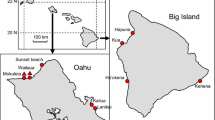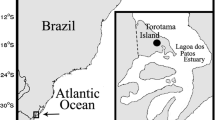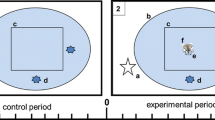Abstract
Several species of sandy beach invertebrates regularly switch between burial in the sand during the day and surface activity at night to feed on stranded organic matter. Because all species consume essentially the same type of food (i.e., wrack) deposited over a restricted area, the potential for competition exists. Conversely, spatial and temporal segregation of surface activity behaviour is predicted to allow for niche separation. Here, we tested whether such behavioural niche separation occurs in three species of sympatric crustaceans (the talitrid amphipods Talitrus saltator (Montagu 1808) and Talorchestia brito Stebbing 1891, and the oniscoidean isopod Tylos europaeus Arcangeli 1938). We also assessed whether surface activity is modulated by weather, sea conditions and moon phases. Surface activity was measured over three consecutive moon phases on an exposed beach on the Atlantic Coast of Spain using pitfall traps along three transects from the foredunes to the swash. Adults of the amphipod T. saltator and the isopod T. europaeus overlapped spatially and temporally in their surface activity for most of the night. By contrast, the activity of T. brito was strongly disjunct in time and concentrated into significantly shorter bouts around dawn or dusk. Niche differentiation was also evident along the space axis, where T. brito occurred distinctly lower on the beach. Although several environmental factors (e.g., air and sand temperature, humidity, atmospheric pressure, wind speed and wind direction) were correlated with surface activity, this was highly variable amongst species, life stages, and synodic phases, and did not obscure the fundamental mosaic of spatio-temporal heterogeneity amongst species. Nocturnal feeding on beach wrack creates the potential for competition amongst sympatric crustaceans which can, however, be mitigated by behaviour patterns that separate consumers in time and space.





Similar content being viewed by others
References
Ansell A (1994) In situ activity of the sandy beach bivalve Donax vittatus (Bivalvia Donacidae) in relation to potential predation risks. Ethol Ecol Evol 6(1):43–53
Benson JA, Lewis RD (1976) An analysis of the activity rhythm of the sand beach amphipod Talorchestia quoyana. J Comp Physiol 105:339–352
Beverly AM, Branch GM (1979) Circadian and circatidal rhythms of oxygen consumption in the sandy beach isopod Tylos granulatus Kraus. J Exp Mar Biol Ecol 37:77–89
Bregazzi PK (1972a) The effects of low temperature upon the locomotor activity rhythm of Talitrus saltator (Montagu) (Crustacea: Amphipoda). J Exp Biol 57:393–399
Bregazzi PK (1972b) The locomotor activity rhythm of Talitrus saltator Montagu (Crustacea, Amphipoda). J Exp Biol 57:393–399
Bregazzi PK, Naylor E (1972) The locomotor activity rhythm of Talitrus saltator Montagu (Crustacea, Amphipoda). J Exp Biol 57:375–391
Cardoso RS (2002) Behavioural strategies and surface activity of the sandhopper Pseudorchestoidea brasiliensis (Amphipoda: Talitridae) on a Brazilian beach. Mar Biol 141:167–173
Chelazzi G, Chellazi L, Focardi S (1983) Dynamic zonation of staphylinoid beetles (Coleoptera:Staphylinoidea) on a sandy beach in East Africa. In: McLachlan A, Erasmus T (eds) Sandy beaches as ecosystems. W.Junk, The Hague, pp 405–412
Clarke KR (1993) Non-parametric multivariate analyses of changes in community structure. Aust J Ecol 18:117–143
Clarke KR, Gorley RN (2006) PRIMER v6: user manual/tutorial PRIMER-E. Plymouth, UK
Clarke KR, Somerfield PJ, Chapman MG (2006) On resemblance measures for ecological studies, including taxonomic dissimilarities and a zero-adjusted Bray-Curtis coefficient for denuded assemblages. J Exp Mar Biol Ecol 330:55–80
Colombini I, Chelazzi L, Falacci M, Palesse I (1994) Zonation and surface activity of some Tenebrionid beetles living on a Mediterranean sandy beach. J Arid Environ 28:215–230
Colombini I, Aloia A, Fallaci M, Chelazzi L (1996) Spatial and temporal strategies in the surface activity of some sandy beach arthropods living along the French Atlantic coast. Mar Biol 127:247–257
Colombini I, Aloia A, Fallaci M, Pezzoli G, Chelazzi L (1998) Spatial use of an equatorial coastal system (east Africa) by an arthropod community in relation to periodically varying environmental conditions. Estuar Coast Shelf Sci 47(5):633–647
Colombini I, Aloia A, Bouslama MF, ElGtari M, Fallaci M, Ronconi L, Scapini F, Chelazzi L (2002) Small scale spatial and seasonal differences in the distribution of beach arthropods on the northwestern Tunisian coast are species evenly distributed along the shore? Mar Biol 140:1001–1012
Colombini I, Chelazzi L, Gibson RN, Atkinson RJA (2003) Influence of marine allochthonous input on sandy beach communities. Oceanogr Mar Biol Annu Rev 41:115–159
Colombini I, Mateo MA, Serrano O, Fallaci M, Gagnarli E, Serrano L, Chelazzi L (2009) On the role of Posidonia oceanica beach wrack for macroinvertebrates of a Tyrrhenian sandy shore. Acta Oecol 35:32–44
Defeo O, McLachlan A (2005) Patterns, processes and regulatory mechanisms in sandy beach macrofauna: a multi-scale analysis. Mar Ecol Prog Ser 295:1–20
Defeo O, Brazeiro A, De Alava A, Riestra G (1997) Is sandy beach macrofauna only physically controlled? Role of substrate and competition in isopods. Estuar Coast Shelf Sci 45:453–462
Dugan JE, Hubbard DM, McCrary MD, Pierson MO (2003) The response of macrofauna communities and shorebirds to macrophyte wrack subsidies on exposed sandy beaches of southern California. Estuar Coast Shelf Sci 58:25–40
Dugan J, Jaramillo E, Hubbard D, Contreras H, Duarte C (2004) Competitive interactions of macroinfaunal animals of exponed sandy beaches. Oecologia 139:630–640
Edwards JM, Naylor E (1987) Endogenous circadian changes in orientational behaviour of Talitrus saltator. J Mar Biol Assoc UK 67:17–26
Fallaci M, Colombini I, Taiti S, Chelazzi L (1996) Environmental factors influencing the surface activity and zonation of Tylos europaeus (Crustacea: Oniscidea) on a Tyrrhenian sandy beach. Mar Biol 125:751–763
Fallaci M, Aloia A, Audoglio M, Colombini I, Scapini F, Chelazzi L (1999) Differences in behavioural strategies between two sympatric Talitrids (Amphipoda) inhabiting an exponed sandy beach of the French Atlantic coast. Estuar Coast Shelf Sci 48:469–482
Fanini L, Cantarini CM, Scapini F (2005) Relationships between the dynamics of two Talitrus saltator populations and the impact of activities linked to tourism. Oceanologia 47:93–112
Hayes WB (1974) Sand-beach energetics: importance of the isopod Tylos punctatus. Ecology 55(4):838–847
Jaramillo E, Contreras H, Duarte C, Avellanal MH (2003) Locomotor activity and zonation of upper shore arthropods in a sandy beach of north central Chile. Estuar Coast Shelf Sci 58:177–197
Kennedy F, Naylor E, Jaramillo E (2000) Ontogenetic differences in the circadian locomotor activity rhythm to talitrid amphipod crustacean Orchestoidea tuberculata. Mar Biol 137:511–517
Ketmaier V, Iuri V, De Matthaeis E (2003) Exploratory analysis of talitrid population genetics as an indicator of the quality of sandy beaches. Estuar Coast Shelf Sci 58:159–167
Lastra M, de la Huz R, Sanchez-Mata AG, Rodil IF, Aerts K, Beloso S, Lopez J (2006) Ecology of exposed sandy beaches in northern Spain: environmental factors controlling macrofauna communities. J Sea Res 55:128–140
Lastra M, Page M, Dugan J, Hubbard D, Rodil I (2008) Processing of allochthonous macrophyte subsidies by sandy beach consumers: estimates of feeding rates and impacts on food sources. Mar Biol 154:163–174
Manning LM, Lindquist N (2003) Helpful habitant or pernicious passenger: interactions between an infaunal bivalve, an epifaunal hydroid and three potential predators. Oecologia 134:415–422
Marques JC, Goncalves SC, Pardal MA, Chelazzi L, Colombini I, Fallaci M, Bouslama MF, El Gtari M, Charfi-Cheikhrouha F (2003) Comparison of Talitrus saltator (Amphipoda: Talitridae) biology, dynamics and secondary production in Atlantic (Portugal) and Mediterranean (Italy and Tunisia) populations. Estuar Coast Shelf Sci 58S:127–148
McLachlan A (1998) Interactions between two species of Donax on a high energy: an experimental approach. J Moll Stud 64:492–495
Mezzetti MC, Naylor E, Scapini F (1994) Rhythmic responsiveness to visual stimuli in different populations of talitrid amphipods from Atlantic and Mediterranean coasts: an ecological interpretation. J Exp Mar Biol Ecol 181:279–291
Nardi M, Morgan E, Scapini F (2003) Seasonal variation in the free running period in two Talitrus saltator populations from Italian beaches differing in morphodynamics and human disturbance. Estuar Coast Shelf Sci 58S:199–206
Nasri K, Morgan E (2006) Seasonality of the endogenous activity rhythm in Talitrus saltator (Montagu) from a sandy beach in northern Tunisia. Biol Rhythm Res 37(6):479–488
Odendaal FJ, Eekhout S, Brown AC, Branch GM (1999) Aggregations of the sandy-beach isopod, Tylos granulatus: adaptation or incidental-effect? S Afr J Zool 34(4):180–189
Olabarria C, Lastra M, Garrido J (2007) Succession of macrofauna on macroalgal wrack of an exposed sandy beach: effects of patch size and site. Mar Environ Res 63:19–40
Palmer JD (1995) The biological rhythms and clocks of the intertidal animals. Oxford University Press, New York
Pavesi L, Iannilli V, Zarattini P (2007) Temporal and spatial distribution of three supralitoral amphipod species on a sandy beach of central Italy. Mar Biol 151:1585–1595
Rodil IF, Olabarria C, Lastra M, Lopez J (2008) Differential effects of native and invasive algal wrack on macrofaunal assemblages inhabiting exposed sandy beaches. Exp Mar Biol Ecol 358:1–13
Scapini F, Chelazzi L, Colombini I, Fallaci M (1992) Surface activity, zonation and migrations of Talitrus saltator on a Mediterranean beach. Mar Biol 112:573–581
Scapini F, Lagar MC, Mezzetti MC (1993) The use of slope and visual information in sandhoppers: innateness and plasticity. Mar Biol 115(4):454–553
Scapini F, Buiatti M, De Matthaeis E, Mattoccia M (1995) Orientation behaviour and heterozygosity of sandhopper populations in relation to stability of beach environments. J Evol Biol 8:43–52
Scapini F, Audoglio M, Chelazzi L, Colombini I (1997) Astronomical, landscape and climatic factors influencing oriented movements of Talitrus saltator. Mar Biol 128:63–72
Scapini F, Aloia A, Bouslama MF, Chelazzi L, Colombini I, El Gtari M, Fallaci M, Marchetti GM (2002) Multiple regression analysis of the sources of variation in orientation of two sympatric sandhoopers, Talitrus saltator and Talorchestia brito, from an expose Mediterranean beach. Behav Ecol Sociobiol 51:403–414
Scapini F, Chelazzi L, Colombini I, Fallaci M, Fanini L (2005) Orientation of sandhoppers at different points along a dynamic shoreline in southern Tuscany. Mar Biol 147(4):919–926
Schlacher TA, Wooldridge T (1994) Tidal influence on distribution and behaviour of the estuarine opossum shrimp Gastrosaccus brevifissura. In: Dyer KR, Orth RJ (eds) Changes in fluxes in estuaries. Olsen and Olsen, Fredensborg, pp 314–318
Schlacher TA, Schoeman DS, Dugan JE, Lastra M, Jones A, Scapini F, McLachlan A (2008) Sandy beach ecosystems: key features, sampling issues, management challenges and climate change impacts. Mar Ecol 29(S1):70–90
Takahashi K, Hirose T, Azuma N, Kawaguchi K (2004) Diel and intraspecific variation in vulnerability of the beach mysid, Archaeomysis kokuboi li, (1964) to fish predators. Crustaceana 77(6):717–728
Ugolini A, Morabito F, Taiti S (1995) Innate landward orientation in the littoral isopod Tylos europaeus. Ethol Ecol Evol 7:387–391
Ugolini A, Fantini T, Innocenti R (2002a) Orientation at night: an innate moon compass in sandhoppers (Amphipoda: Talitridae). Proc R Soc Lond B 270:279–281
Ugolini A, Meucci L, Tiribilli B, Lindstroem M (2002b) The local optical factor as an orientation cue for the sandhopper Talitrus saltator Montagu (Amphipoda, Talitridae). Mar Freshw Behav Physiol 35:27–36
Williams JA (1980) The effect of dusk and dawn on the locomotory activity rhythm of Talitrus saltator (Montagu) (Crustacea: Amphipoda). J Exp Mar Biol Ecol 42:285–297
Williams JA (1983) The endogenous locomotor activity rhythm of four supralittoral peracarid crustaceans. J Mar Biol Assoc UK 63(2):481–492
Zar JH (1996) Biostatistical analysis, 4th edn. Prentice Hall, New Jersey
Acknowledgments
We thank our field assistants whose help was instrumental in catching all those little crustaceans. “Thank you” to Arabela Sanchez-Mata, Charo de la Huz, Iván Rodil, Mónica Incera, Adoración Sanchez-Mata, Jesús López and Germán Rodríguez. This study was funded by the Spanish Ministry of Education and Science (CGL2005-02269).
Author information
Authors and Affiliations
Corresponding author
Additional information
Communicated by S. D. Connell.
Rights and permissions
About this article
Cite this article
Lastra, M., Schlacher, T.A. & Olabarria, C. Niche segregation in sandy beach animals: an analysis with surface-active peracarid crustaceans on the Atlantic coast of Spain. Mar Biol 157, 613–625 (2010). https://doi.org/10.1007/s00227-009-1346-3
Received:
Accepted:
Published:
Issue Date:
DOI: https://doi.org/10.1007/s00227-009-1346-3




